Dancing with the Cosmos: Three Decades of Work from Kumari Nahappan
Through her works, Nahappan invites us to join her on an exciting, terrifying and beautiful journey—to contend with the existence of countless universes and their interconnected cycles.
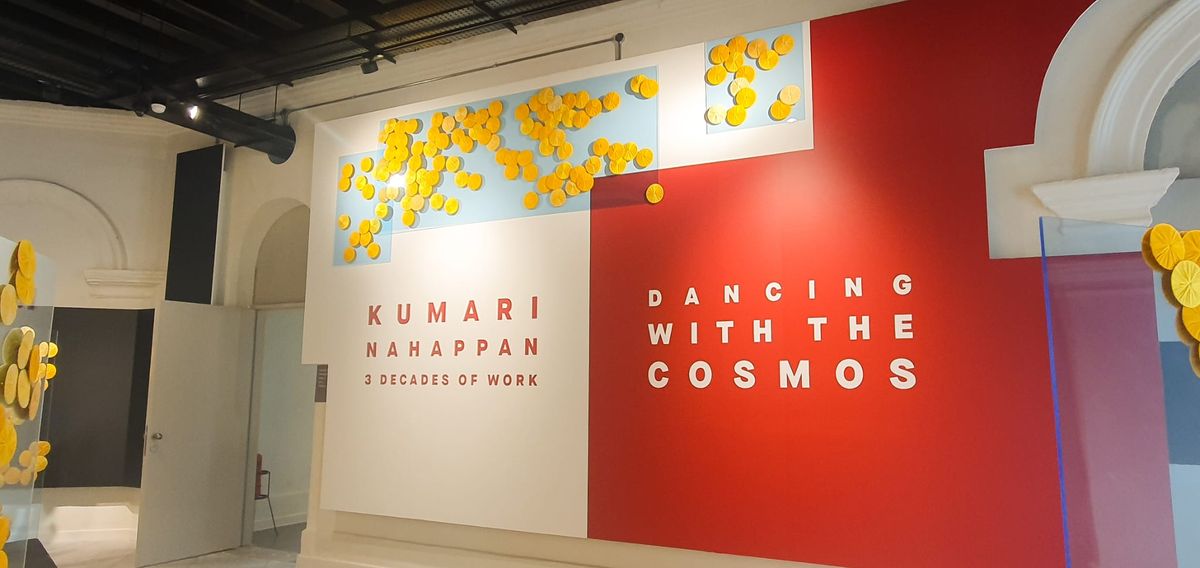
After a temporary closure of over two years, The Private Museum Singapore has finally opened its doors to the public once again. Previously located at 51 Waterloo Street, the Museum now finds itself nestled at the very top of Mount Emily, occupying the former Osborne House at 11 Upper Wilkie Road. This colonial-era villa was previously occupied by Kult Kafe, a neighbourhood bar and performance space that has now relocated to Turf Club Road. Yet, the building’s history stretches much further back—first mentioned in records from the late 1800s, it served as the Japanese Consulate Office during World War 2 and later as a Childrens’ Home.
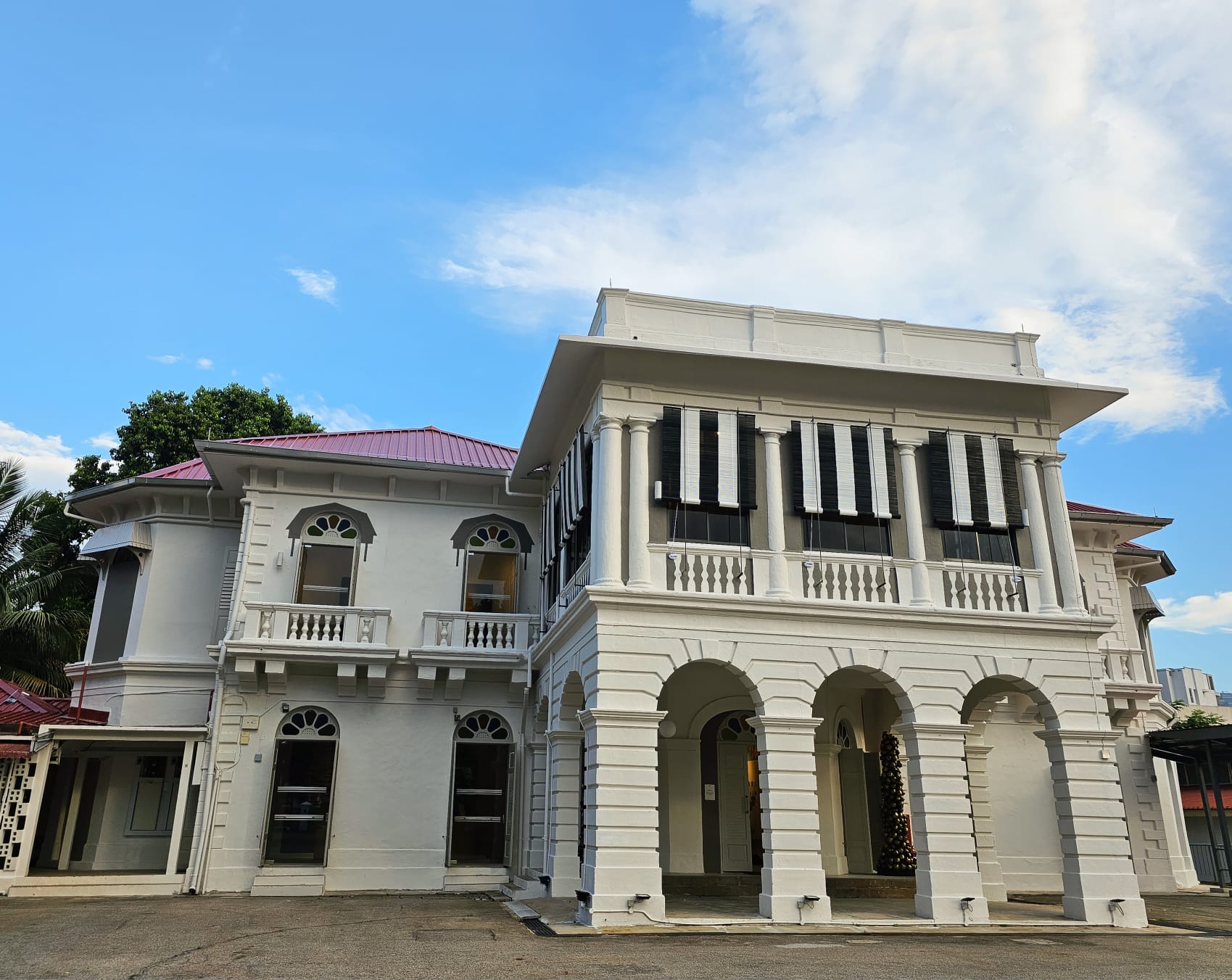
In a bid to give the building a new lease of life, the Museum has collaborated with award-winning WOHA architects to preserve the old while introducing the new. Quintessential colonial elements have been retained, such as the building’s white-brick exterior, arched doorways and stained glass fanlights. Concurrently, new fixtures such as a wraparound reception-cum-café counter have been installed, while the floor and ceiling have been painted a sleek black. The refreshed house is now a charming space hosting both the Museum’s arts programmes as well as external venue hires.
Dancing with the Cosmos: Three Decades of Work from Kumari Nahappan marks the first of these programmes. Bringing together over 50 paintings, sculptures and installations from renowned Malaysian-born Singaporean artist Kumari Nahappan, the exhibition provides a survey of over 3 decades of her artistic practice. In spite of this, Dancing with the Cosmos opts for a slightly unusual approach: rather than utilising a chronological format, artworks are segregated by colour. Each room within the space contains works that resonate with one another in terms of hue, but which may have been created at different points of Nahappan’s career. In doing so, the nonlinearity of Nahappan’s artistic practice is emphasised—cross-referencing, recurrence, continuity and transmutation are all processes integral to her thematic explorations.

Kumari Nahappan is a contemporary artist born in 1953 in Klang, Malaysia. She is best known for her sculptures and public art, with her larger-than-life replicas of spices and seeds dominating spaces such as ION Orchard and the National Museum of Singapore. However, fewer are aware of her abstract paintings and installations—Dancing with the Cosmos aims to bring these works into greater focus and better understand them in the context of Nahappan’s artistic practice as a whole.
The exhibition also bears the mark of independent curator John Z.W. Tung. Holding a Bachelor’s Degree (Hons) in Arts Management awarded by Goldsmiths, University of London (at LASALLE College of the Arts), Tung has nearly a decade’s worth of experience in the local and regional arts industry. From 2015 to 2020 he was Assistant Curator at the Singapore Art Museum, and since then has created exhibitions for a plethora of local arts organisations including past editions of the Singapore Biennale.
Having the opportunity to watch Tung at work truly makes one understand why he is one of Singapore’s most sought-after curators today. In the planning of the exhibition, what was most apparent was his attention to detail: site specificity formed a crucial foundation for his work in Dancing with the Cosmos. Tung’s creativity, paired with his ability to read spaces and connect them to the myriad qualities of different works, made his curatorial process an honour to witness.
In his survey of the site, Tung paid special attention to how various sections of the Osborne House interacted with its natural environment. For example, works from Nahappan’s Tropical Vibrance (1992), Botanical Garden (1993) and The Garden (1992) series find themselves in the reception and café area, where large windows open up to views of the surrounding greenery. Viewers who drop by for a cup of coffee or a place to sit are hence able to reconcile Nahappan’s nature-based works with nature itself. We are met with greens, yellows, reds and blues in Nahappan’s paintings, and glance outside to compare them with similar hues found in real life.
In the same vein, the placement of Monument (1996/2023) finds itself closely tied to weather elements—more specifically, the sun’s pattern of movement. The work, situated in Caroline Verandah, comprises floor-to-ceiling lengths of yellow fabric that congregate around a circular area of turmeric, within which a tall glass pyramid is buried.

The Caroline Verandah is a gorgeous, front-facing room on the second floor that is well-exposed to natural light. In early site visits, Tung noted that the sun’s path originates from behind the Museum, approximately bisecting the building as the day progresses. By mid-afternoon, sunlight streams directly into the Veranda and pools in golden puddles on the floor. Monument’s reflective surfaces and sunshiney hues allow this light to appear expansive, as it bounces off the rich yellow drapery and bathes the room in amber hues.
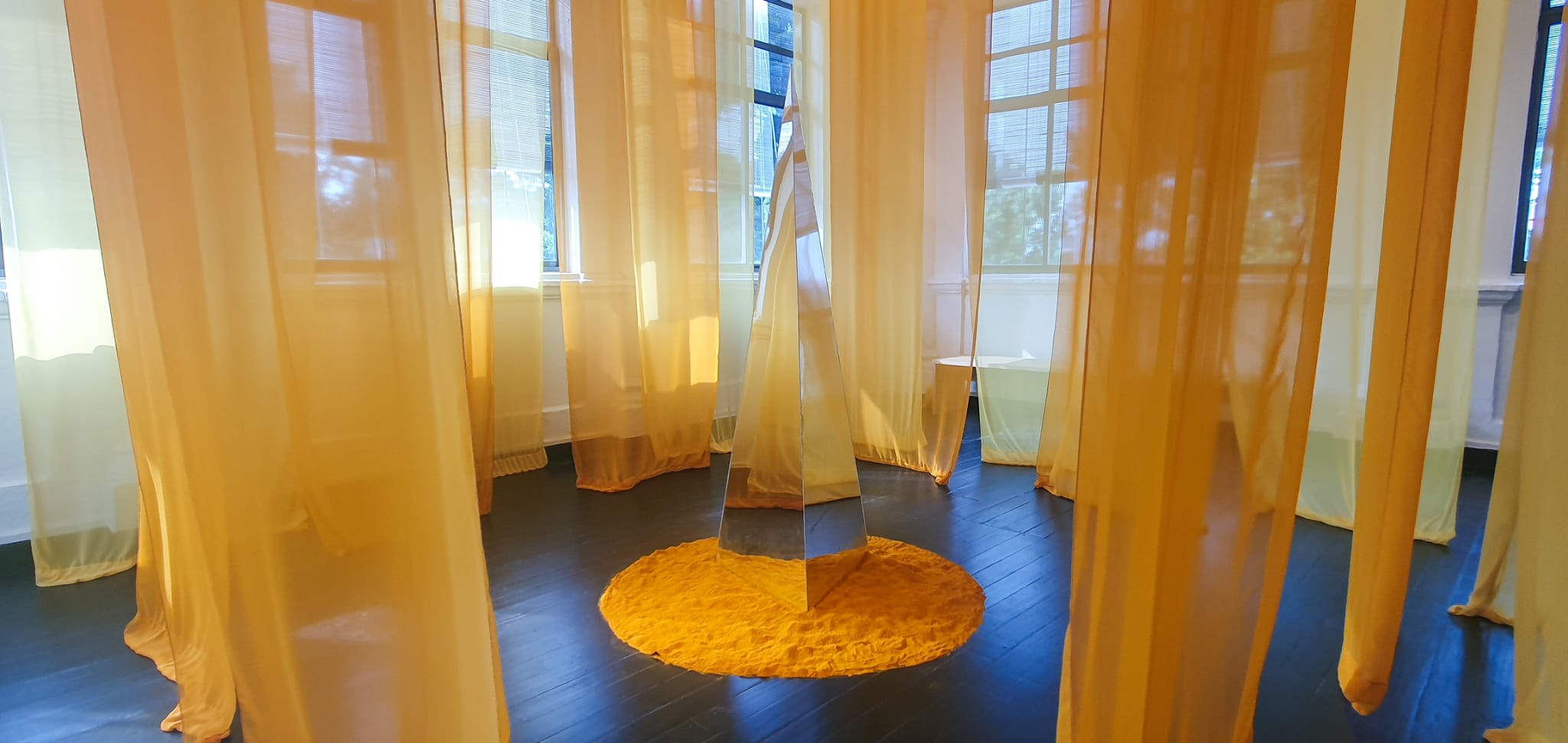
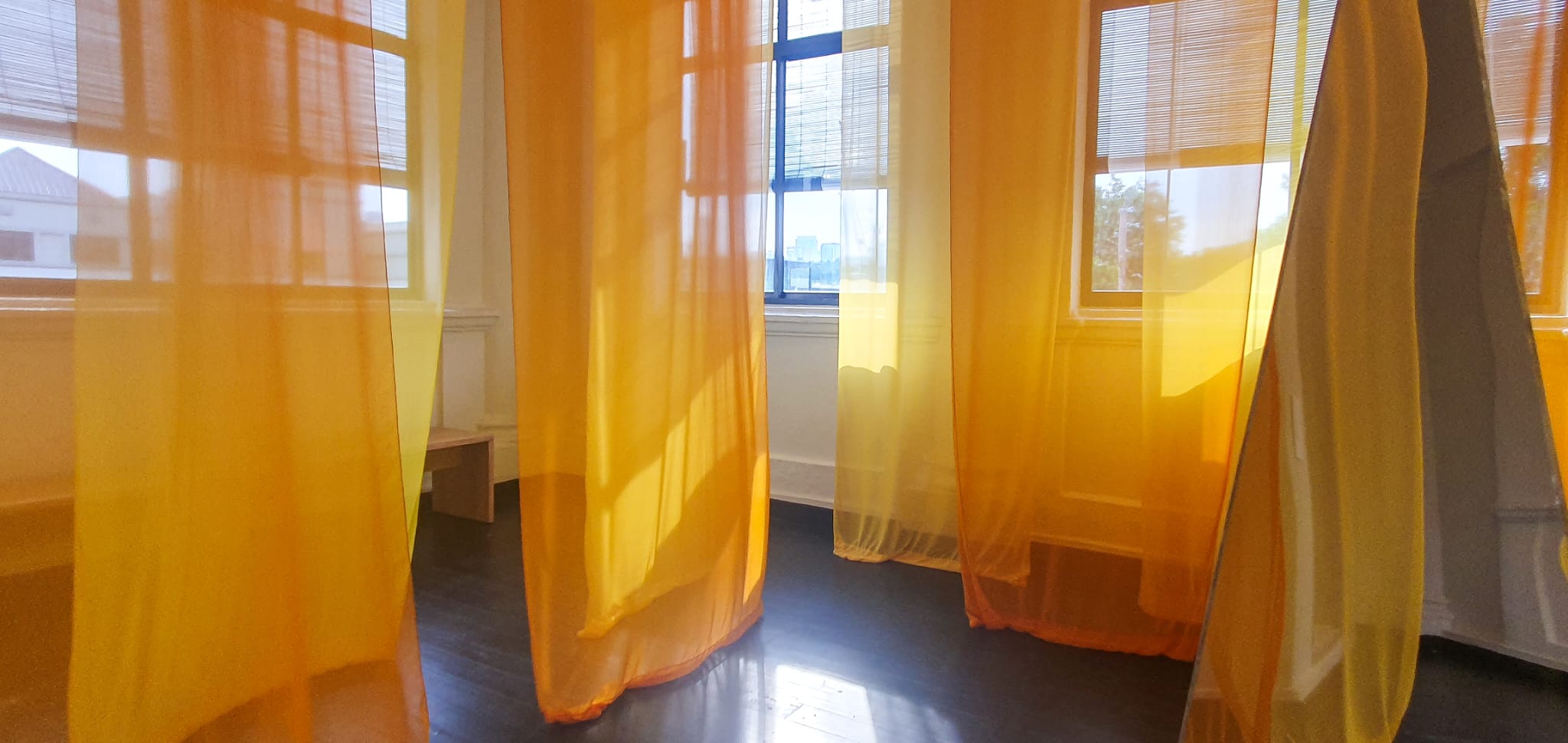
Monument was first presented in 1996 for the Substation’s New Criteria exhibition. It is reiterated in Dancing with the Cosmos at a reduced scale, with one cloth-draped chamber instead of four. However, while the Substation was nestled amongst rows of shophouses within the city, The Private Museum instead overlooks the latter from atop Emily Hill. This new location adds a novel context to the work, emphasised by the Verandah’s many windows that offer a panoramic view of the city. Stepping out from behind the sunshine-soaked drapery, our attention is abruptly brought to the brutalist metropolis knocking at our door—this visual juxtaposition transforms Monument into a space of spiritual respite amidst an engineered skyline. In this way, Tung ingeniously reconciles various elements of climate and environment, setting each work in a site that further adds to its meaning.
Like the turmeric used in Monument—an anti-inflammatory herb vital in Hindu rites for its purifying properties—Nahappan’s artistic practice is trademarked by her use of distinctly Southeast Asian symbols. In Anahata (2013-2023) we find a mountain of red saga seeds native to Southeast Asia, and in Reincarnations (360 Vessels from the temple) (1995/2022) we find winding towers of copper pots used in Hindu rituals. These works are testament of Nahappan’s ability to situate culturally-significant found objects within novel, yet meaningful contexts.



While we have been discussing Nahappan’s installations so far, Dancing with the Cosmos actually sees more of her paintings hung up than anything else. From Nahappan’s iconic colour field paintings showcasing her seamless blending and inquiry into hue, to her textural paintings tinged with her sculptural instincts, the exhibition invites viewers to explore a lesser-known aspect of Nahappan’s practice. Also on display in the blue room is Transcript: Reading Beyond (2015), a work commissioned for the Singapore Art Museum Exhibition, 5 Stars: Art Reflects on Peace, Justice, Equality, Democracy and Progress (2015). This abstract painting is an unconventional portrait of T.K. Sabapathy—a writer, curator, critic and illustrious pioneer of Singapore’s art history field. The triptych features calming gradients of blue and purple, intersected by a golden yellow streak that, through the means of blended paint, appears luminescent.

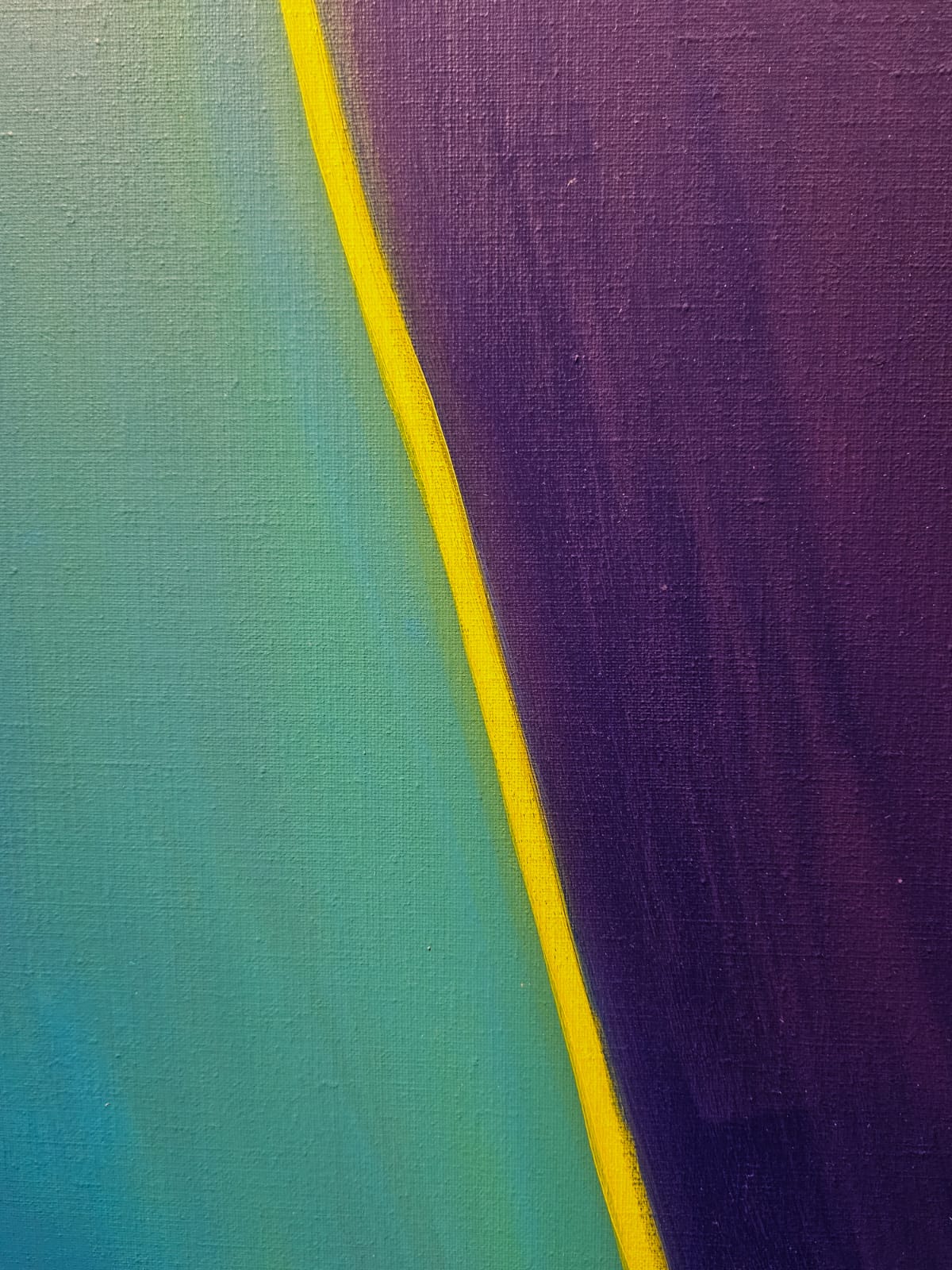
We once again see the significance of colour to Nahappan’s artistic expression. The hues of deep blue and purple are nuanced, rich and almost velvety, reflecting Nahappan’s close friendship with Sabapathy and her consequent understanding of his inner personality. On the other hand, the strips of yellow run steadily and emanate an almost neon glow into the surrounding blue areas. In this we may find vitality and a literal guiding light, perhaps mirroring Sabapathy’s groundbreaking work in the local arts scene over the past 50 years.
Dancing with the Cosmos makes clear the close interrelation between Nahappan’s sculptural, installation and painting practices. Her partiality for symbolism shapes her dancing chillies and draws neon streaks across her paintings. The importance of colour can be felt in her red mountains, yellow chambers and vibrant fields of acrylic paint. Most importantly, the ideas Nahappan values most—nature, nostalgia, family and culture—are the scattered seeds from which each piece blooms.
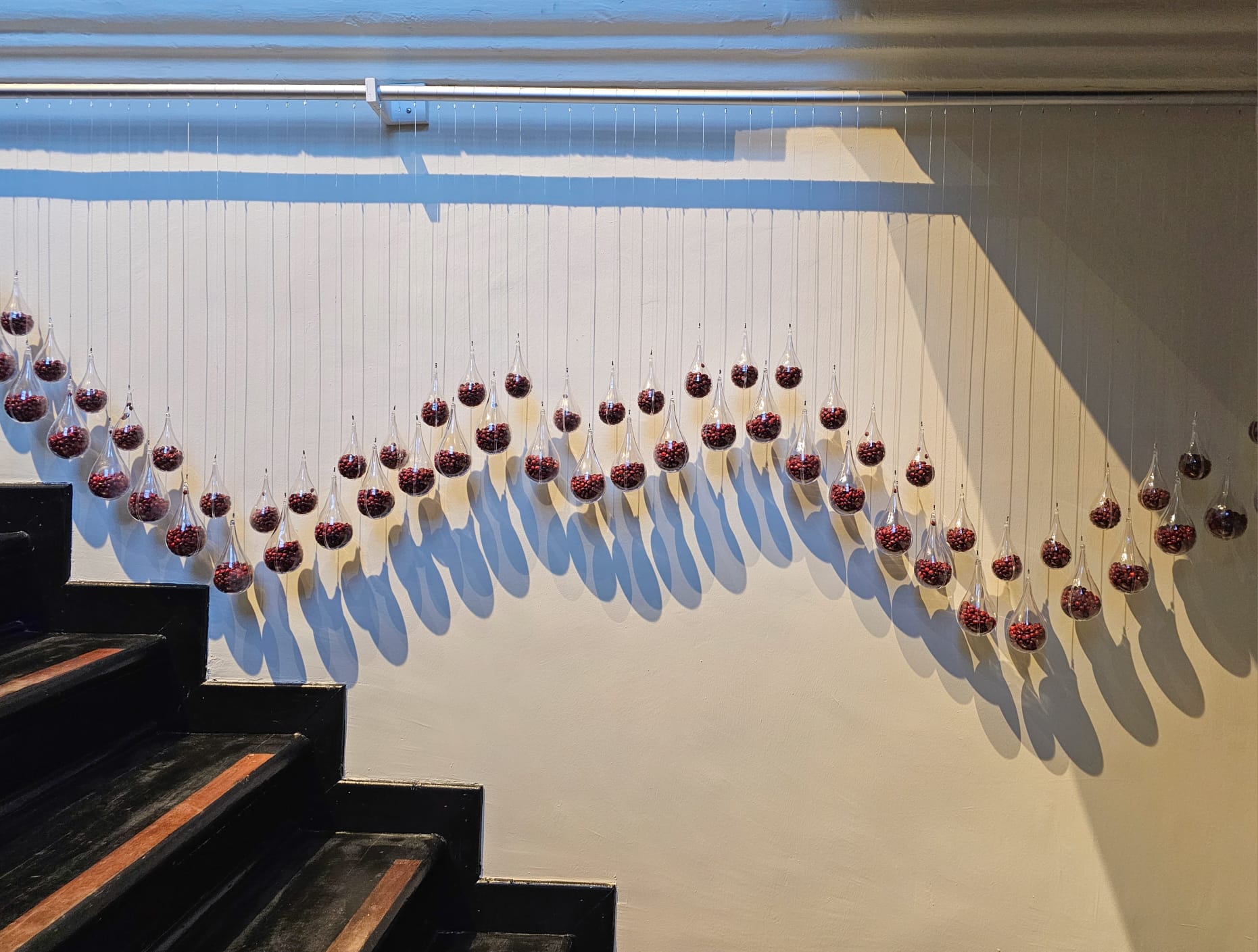

Dance is movement. More importantly, dance is a dynamic act of expression and celebration. The cosmos, on the other hand, comes with connotations of expansiveness and the possession of multitudes. Pondering the cosmos is also a distinctly existential, perhaps even spiritual experience. Through her works, Nahappan invites us to join her on this exciting, terrifying and beautiful journey—to contend with the existence of countless universes and their interconnected cycles.
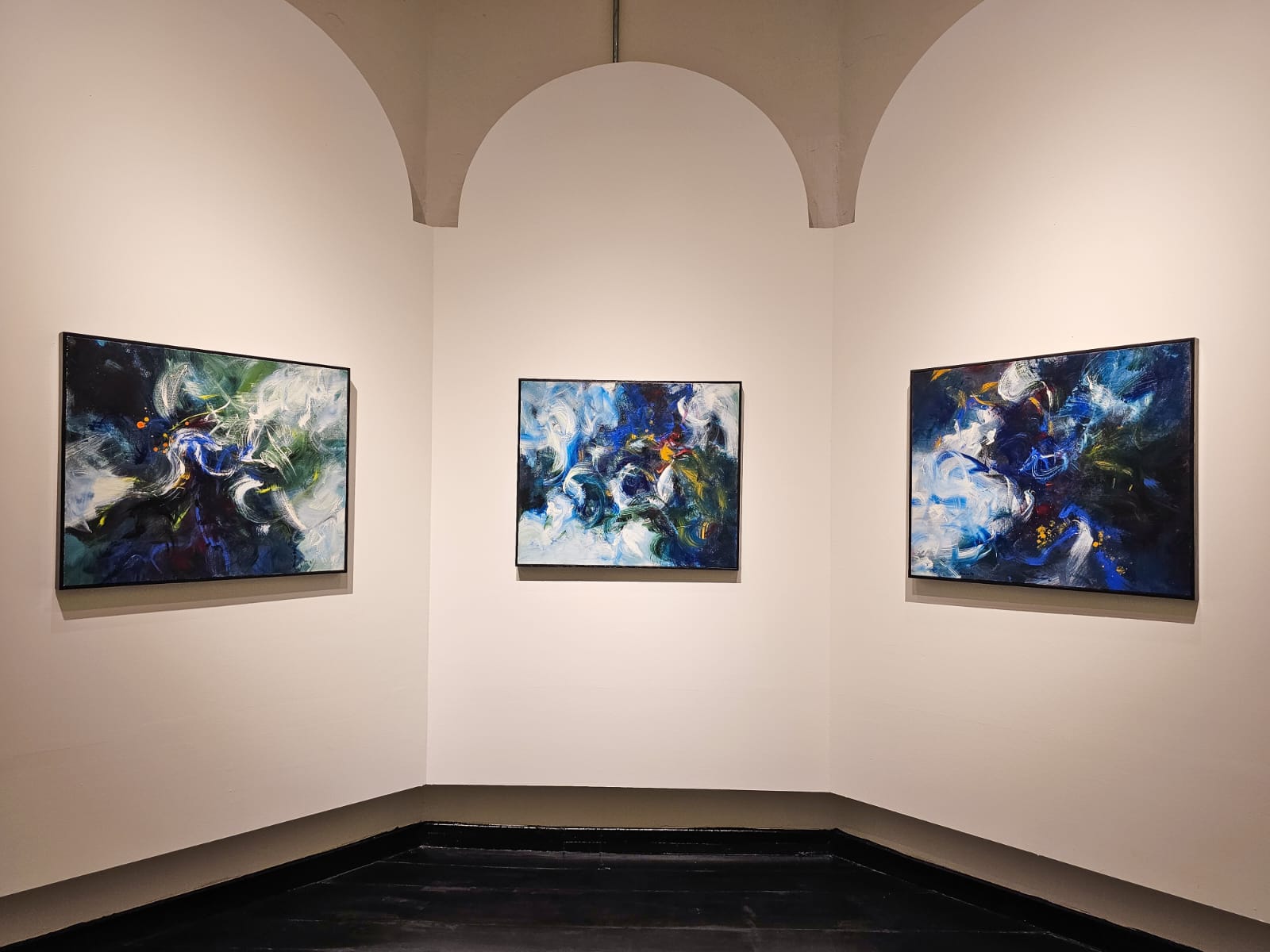
The Private Museum Singapore is a non-profit museum that aims to bridge private collections with public audiences. The Museum is open daily from 10am-7pm (weekdays) or 11am-5pm (weekends). Public Holidays and other timings by appointment only. Find them at 11 Upper Wilkie Road, Singapore 228120, or find out more on their website.